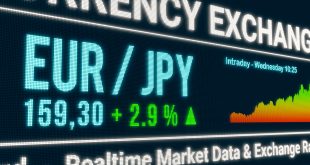Gold was up 0.6% to $1,797.5, silver was up 0.5% to $22.41 an ounce, and copper was up 0.4% to $4.33 per pound. Among energy ETFs, the United States Oil Fund was up 0.6% to $62.35, and the United States Natural Gas Fund was up 5.4% to $17.16.
US equities advanced after midday on Monday as technology and consumer discretionary sectors, which were among the worst performers last week, rebounded.
The Nasdaq Composite jumped 2.4% to 14,101.01, with the S&P 500 up by 1.2% to 4,485.12. The Dow Jones Industrial Average climbed 0.6% to 34,938.32 after briefly trading in negative territory earlier.
Economic Data
Consumer discretionary jumped 3%, technology climbed 1.5%, and communication services higher by 1.6%. All sectors were in the green territory by Monday afternoon.
Activity at factories in the U.S. Midwestern region defied expectations by gaining momentum in January. The Chicago purchasing managers’ index (PMI) delivered a fresh reading of 65.2, indicating manufacturing expansion accelerated in the first month of 2022, rising from December’s upwardly revised 64.3 and coming in well above the 61.7 consensus, which would have indicated a modest slowdown.
Institute for Supply Management’s (ISM) more broad, national PMI data expected on Tuesday, which analysts expect will come in at 57.5, a 1.1 point drop from the December reading. The two indexes largely track each other, although ISM’s country-wide data is understandably less volatile:
Other Developments
US Treasury yields drew some strength in the last trading day of January from the improvement in risk appetite in global financial markets due to a respite in risk assets from the negative effects of escalating interest rate hike expectations after the statements of Atlanta Fed Chairman Rafael Bostik. US Treasury yields for ten years rose to 1.78% compared to the last daily close, which recorded 1.771%.
Yields on this type of sovereign securities fell to their lowest level over the course of Monday’s trading at 1.770%, compared to the lowest level recorded at 1812%.
L3Harris Technologies (LHX) reported mixed fourth-quarter results as revenue declined mainly due to divesture in the aviation systems segment and supply chain constraints. The full-year guidance of the defense contractor was below consensus. Shares dropped 3.9% intraday, the worst performer on the S&P 500.
Shares of Netflix (NFLX) were up 10%, among the top gainers on the S&P 500 and Nasdaq, following upgrades at Citigroup and Edward Jones.
The Federal Reserve was probably the main initiator of the market turmoil last week, and traders and investors will remain hypersensitive to any further developments in monetary policy over the short run.
The 10-year US Treasury yield climbed less than one basis point to 1.79%. Based on the 10-year yield dipping back below 1.80%, the central bank could throttle back on its aggressive inflation-fighting stance over the coming weeks and months as data shows a slowdown across developed and emerging markets.
Also Read:
Inflation, Deficits Cannot Dim Appeal of US Treasury Bonds
US Shares Advance as Technology, Consumer Discretionary Stocks Rebound
Fed’s Barkin: Rate Hikes Pace Depends On Inflation
Gold Touches Fresh High As USD Flattened
Fed’s Bostic Expects Three Rate Hikes In 2022
EUR/USD Traders Exploit Critical Resistance In US Session
Fed’s George: Aggressive balance sheet reduction may allow shallower rate path
Will BoE hike rates on Thursday?
SNB Chair Jordan: We have to take inflation developments seriously
NFP expected to fall by 100000 in January
NZD/USD Rebounds Amid Improved Risk Appetite
Forecasts from eight major banks on RBA’S monetary policy
 Noor Trends News, Technical Analysis, Educational Tools and Recommendations
Noor Trends News, Technical Analysis, Educational Tools and Recommendations





